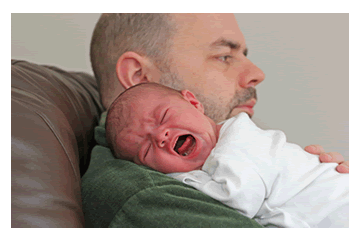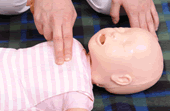AHT Assessment
Precipitating factors
 The most common precipitating event for AHT is crying (Barr, 2012). It is not unusual for infants to cry for long periods of time even though they have been fed, changed and held with great care. Parents or a caregiver can become frustrated and angry because of the crying leading to shaking or slamming the baby. These feelings can be enhanced by family members complaining about the crying and blaming the caregiver. Men are more likely to shake or slam infants than women. Other factors include the follow:
The most common precipitating event for AHT is crying (Barr, 2012). It is not unusual for infants to cry for long periods of time even though they have been fed, changed and held with great care. Parents or a caregiver can become frustrated and angry because of the crying leading to shaking or slamming the baby. These feelings can be enhanced by family members complaining about the crying and blaming the caregiver. Men are more likely to shake or slam infants than women. Other factors include the follow:
- Unrealistic expectations of babies
- Young or single parenthood
- Stress
- Domestic violence
- Alcohol or substance abuse
- Unstable family situations
- Depression
- A history of violence within the family structure
- Poverty
- Lack of education and resources:
https://www.dontshake.org/learn-more/itemlist/category/13-facts-info#predisposing-factors-in-shaken-baby-syndrome-abusive-head-trauma-sbs-aht
Signs and symptoms of AHT
It is important to identify the signs and symptoms of AHT and other forms of injuries or illnesses that many have similar presenting symptoms. According to Joyce and Huecker (2018) parents or other caregivers will generally not initially admit to a child being shaken. They are more likely to say the child fell down the stairs or out of a crib, which can happen. The following are possible Signs and Symptoms of AHT.
- Lethargy / decreased muscle tone
- Extreme irritability
- Decreased appetite, poor feeding or vomiting for no apparent reason
- Grab-type bruises on arms or chest
- No smiling or vocalization
- Poor sucking or swallowing
- Rigidity or posturing
- Difficulty breathing
- Decreased level of consciousness
- Seizures
- Head or forehead appears larger than usual
- Soft spot on head appears to be bulging
- Inability to lift head
- Inability of eyes to focus or track movement
- Unequal size of pupils
https://www.mayoclinic.org/diseases-conditions/shaken-baby-syndrome/symptoms-causes/syc-20366619
https://www.dontshake.org/learn-more
Other symptoms commonly occurring with AHT, not visible initially but available on x-rays, include bleeding in the brain and eyes, spinal cord damage, and fractures of the ribs, skull, legs and other bones. Milder cases of AHT can lead to health or behavioral problems later in life. It is necessary to distinguish injuries due to accidental injuries and AHT.
Diagnosis of AHT and Shaken Baby Syndrome eliminating other causes
 An accurate diagnosis may call for a team of medical specialists to be involved. Typically, pediatricians, ophthalmologists, neurologist/neurosurgeons, orthopedic physicians may consult. During the diagnostic time, other tests are performed, and the history evaluated to rule out other causes of the trauma. Retinal hemorrhages can occur from CPR which can occur with these infants. Retinal hemorrhages from CPR are due to increased intrathoracic pressure, Purtscher retinopathy, often occurring with rib fractures. CPR induced retinopathy includes cotton wool spots with white retinal patches. Retinal hemorrhages from AHT will typically not have the cotton wool spots with the white retinal patches or rib fractures like those seen from CPR. https://cybersight.org/wp-content/uploads/2017/05/abusive-head-traumas.pdf. The team will use clinical history, physiologic data, and imaging to establish when the injuries occurred.
An accurate diagnosis may call for a team of medical specialists to be involved. Typically, pediatricians, ophthalmologists, neurologist/neurosurgeons, orthopedic physicians may consult. During the diagnostic time, other tests are performed, and the history evaluated to rule out other causes of the trauma. Retinal hemorrhages can occur from CPR which can occur with these infants. Retinal hemorrhages from CPR are due to increased intrathoracic pressure, Purtscher retinopathy, often occurring with rib fractures. CPR induced retinopathy includes cotton wool spots with white retinal patches. Retinal hemorrhages from AHT will typically not have the cotton wool spots with the white retinal patches or rib fractures like those seen from CPR. https://cybersight.org/wp-content/uploads/2017/05/abusive-head-traumas.pdf. The team will use clinical history, physiologic data, and imaging to establish when the injuries occurred.
Jenny, Hymel & Ritzen (1999) carried out a retrospective review of 173 children younger than 3 years old with a diagnosis of AHT. They found 31% of the AHT cases were initially missed by medical professionals. The presence of additional injuries and misinterpretation of imaging studies contributed to the missed diagnosis.
For more details about images of injuries go to https://www.ajronline.org/doi/
10.2214/AJR.16.17602
Recommendations by Mayo clinic staff include the following procedures for a thorough diagnostic assessment:
- Skeletal survey which includes several bone X-rays
- Eye exam
- Blood tests, particularly clotting and bleeding tendencies to rule out other causes of the symptoms
- Magnetic resonance imaging (MRI) to examine brain trauma
- Computerized tomography (CT) scan, done particularly to detect injuries that need immediate attention.
https://www.mayoclinic.org/diseases-conditions/shaken-baby-syndrome/diagnosis-treatment/drc-20366641.
Instant Feedback:
Poverty is the most common precipitating factor associated with AHT.
References
Barr, R. G. (2014). Crying as a trigger for abusive head trauma: A key to prevention. Pediatric. Radiology, 44, 59 -64.
Jenny, C., Hymel, K.P., Ritzen, A, et al. (1999) Analysis of missed cases of abusive head trauma. JAMA 281, 621–626.
Joyce, T. & Hueckler, M. (2018). Pediatric Abusive Head Trauma (Shaken Baby Syndrome) StatPearls. https://www.ncbi.nlm.nih.gov/books/NBK499836/.
©RnCeus.com
 The most common precipitating event for AHT is crying (Barr, 2012). It is not unusual for infants to cry for long periods of time even though they have been fed, changed and held with great care. Parents or a caregiver can become frustrated and angry because of the crying leading to shaking or slamming the baby. These feelings can be enhanced by family members complaining about the crying and blaming the caregiver. Men are more likely to shake or slam infants than women. Other factors include the follow:
The most common precipitating event for AHT is crying (Barr, 2012). It is not unusual for infants to cry for long periods of time even though they have been fed, changed and held with great care. Parents or a caregiver can become frustrated and angry because of the crying leading to shaking or slamming the baby. These feelings can be enhanced by family members complaining about the crying and blaming the caregiver. Men are more likely to shake or slam infants than women. Other factors include the follow: An accurate diagnosis may call for a team of medical specialists to be involved. Typically, pediatricians, ophthalmologists, neurologist/neurosurgeons, orthopedic physicians may consult. During the diagnostic time, other tests are performed, and the history evaluated to rule out other causes of the trauma. Retinal hemorrhages can occur from CPR which can occur with these infants. Retinal hemorrhages from CPR are due to increased intrathoracic pressure, Purtscher retinopathy, often occurring with rib fractures. CPR induced retinopathy includes cotton wool spots with white retinal patches. Retinal hemorrhages from AHT will typically not have the cotton wool spots with the white retinal patches or rib fractures like those seen from CPR.
An accurate diagnosis may call for a team of medical specialists to be involved. Typically, pediatricians, ophthalmologists, neurologist/neurosurgeons, orthopedic physicians may consult. During the diagnostic time, other tests are performed, and the history evaluated to rule out other causes of the trauma. Retinal hemorrhages can occur from CPR which can occur with these infants. Retinal hemorrhages from CPR are due to increased intrathoracic pressure, Purtscher retinopathy, often occurring with rib fractures. CPR induced retinopathy includes cotton wool spots with white retinal patches. Retinal hemorrhages from AHT will typically not have the cotton wool spots with the white retinal patches or rib fractures like those seen from CPR.